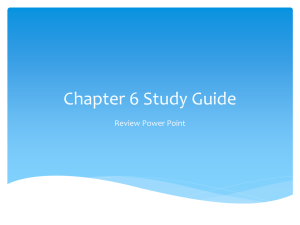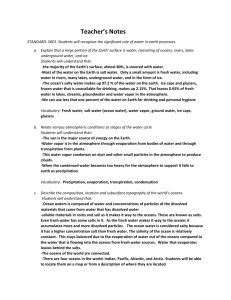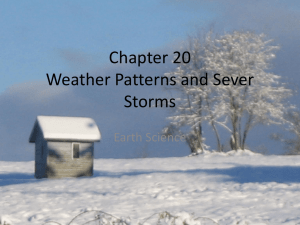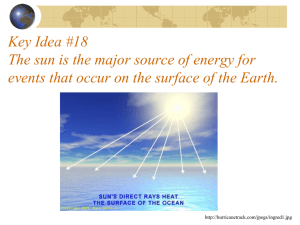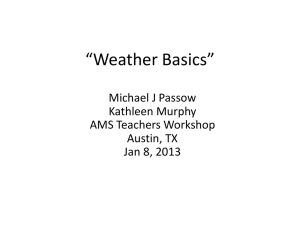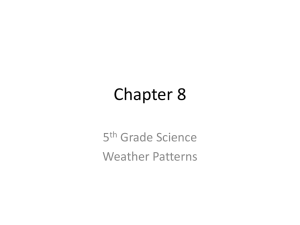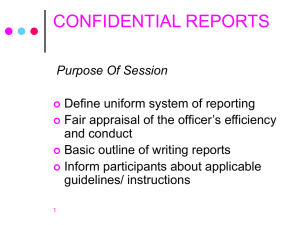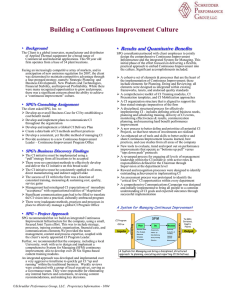Weather and Climate - Lunar and Planetary Institute
advertisement
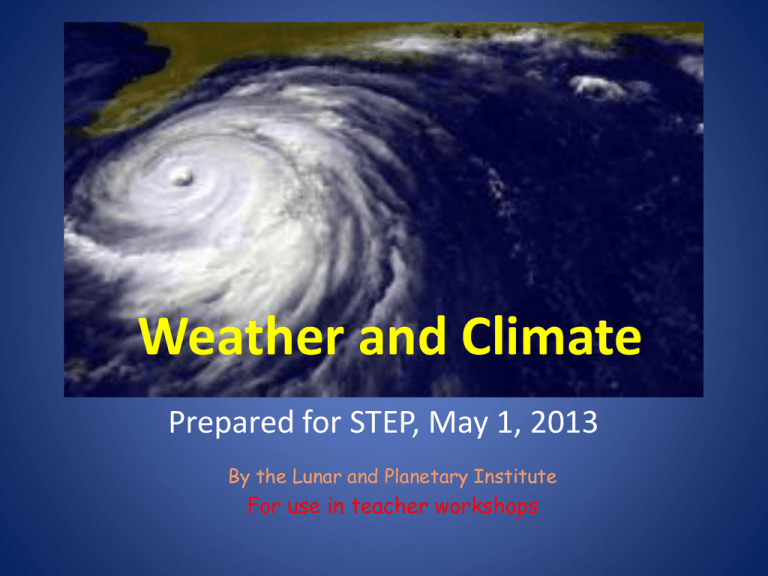
Weather and Climate Prepared for STEP, May 1, 2013 By the Lunar and Planetary Institute For use in teacher workshops TEKS (8th grade) (10) Earth and space. The student knows that climatic interactions exist among Earth, ocean, and weather systems. The student is expected to: (A) recognize that the Sun provides the energy that drives convection within the atmosphere and oceans, producing winds and ocean currents; (B) identify how global patterns of atmospheric movement influence local weather using weather maps that show high and low pressures and fronts; and (C) identify the role of the oceans in the formation of weather systems such as hurricanes. Engagement • Why is weather important in Texas? Spend 3 minutes sharing your thoughts with 1 partner. • Is climate important in Texas? Underlying Forces, Connections In order to understand weather and climate, students need to be familiar with certain physical concepts: • Density and its relationship to temperature • Convection • How energy can be transferred • Pressure Assessments Table Texting: • Write in the question box “The difference between weather and climate is” • Then write your opinion in the “My Response” bubble • Pass your paper to others at the table, writing replies to whatever the previous “text” said; each sheet should have things written by 4 people. Show video at http://video.nationalgeographic.com/video/science/earthsci/climate-weather-sci/ Vocabulary terms • Weather • Radiation • Absorption • Convection • • • • • Currents Meteorology Atmosphere Forecast Climate • • • • • • • • Air pressure Water Cycle Fronts Humidity Temperature Precipitation Hurricane Tornado – “Climate is what you expect; Weather is what you get.” ~Mark Twain – “Weather is what you wear each day, and climate is what’s in your closet!” (A) recognize that the Sun provides the energy that drives convection within the atmosphere and oceans, producing winds and ocean currents; • How does the Sun’s energy drive our weather and climate systems? Think-Pair-Share • Best procedures: read quietly to yourself (so you don’t give any unconscious clues) • As the instructor, we read it too, for timing, then ask if anyone needs more time • If not, it’s time to vote simultaneously—use your fingers, right in front of your chest so others don’t see (anonymous) The Sun warms the Earth’s atmosphere primarily because 1. The sunlight is absorbed by the atmosphere. 2. The sunlight and heat from the Sun are absorbed by the atmosphere. 3. The sunlight is absorbed by the land and oceans. 4. The sunlight and heat from the Sun are absorbed by the land and oceans. 5. The infrared light from the Sun warms the Earth. Earth’s Radiation Budget Visible Light From http://ceres.larc.nasa.gov/ceres_brochure.php?page=2 Time for some activities! • A Comparison of Land and Water Temperature http://mynasadata.larc.nasa.gov/lesson-plans/lesson-plans-middle-schooleducators/?page_id=474?&passid=36 Students examine NASA satellite observations of surface temperature. • Fireproof Balloon http://www.imcpl.org/kids/blog/?p=10660 This demonstration can be used to get students to think about heat capacity. • Are Cold Liquids More Dense than Warm Liquids? http://www.nasa.gov/centers/langley/pdf/245900main_MeteorologyTeacherRes-Ch9.r3.pdf Verifying that warmer air is lighter than cooler air helps to take some of the abstractness out of developing a basic understanding of weather. Students examine this principal with liquids instead of gases. • Weather Stations: Winds http://www.lpi.usra.edu/education/explore/solar_system/activities/weatherStations/winds/ Students use a toaster to generate wind and discover that convection drives wind. REVIEWING: Slides from http://greenslime.info/notes.html The solar radiation heats the surface of the Earth. Heat is transferred to air molecules that come in contact with the ground or ocean. REVIEWING: Slides from http://greenslime.info/notes.html As the Warmer Air Rises… Cooler air is pulled in from other places Cooler air is pulled in from other places Convection REVIEWING: Slides from http://greenslime.info/notes.html Where else do we see convection? REVIEWING: Slides from http://greenslime.info/notes.html Convection current – the transfer of heat energy through a fluid due to gravity Image from http://pubs.usgs.gov/gip/deserts/atmosphere/ Think, Pair, Share… How does a convection current work? Why do we have wind? How does the Sun’s energy drive ocean currents? Image from Windows to the Universe Visuals of Currents and winds • See http://www.fastcodesign.com/1669361/better-than-avan-gogh-nasa-visualizes-all-the-worlds-ocean-currents And http://www.classzone.com/books/earth_science/terc/conten t/visualizations/es2401/es2401page01.cfm?chapter_no=visu alization (B) identify how global patterns of atmospheric movement influence local weather using weather maps that show high and low pressures and fronts; Activities: The STORM Project • Activity 5: Fronts http://www.uni.edu/storm/downloads/Level2/Fronts-5.pdf Christine’s recommendation: Use this image http://www.uni.edu/storm/wximages/images/usfronts.gif and http://www.uni.edu/storm/wximages/images/sfc_map.gif and skip questions about winds Students examine temperatures and precipitation compared to fronts. Possible addition; invite students to compare air pressure numbers (http://www.uni.edu/storm/wximages/images/pmsl.gif) to the fronts map as well. • Activity 7: Precipitation Patterns http://www.uni.edu/storm/activities/level2/act7.shtml http://www.uni.edu/storm/downloads/Level2/Precipitation%20Patterns-7.pdf Students will demonstrate the relationship between precipitation types and surface temperatures. They will use forecast maps to predict where snow or rain will fall over the next several days. REVIEWING: Slides from http://greenslime.info/notes.html The Wind • Result of uneven heating of the Earth’s surface – causes differences in air pressure to develop (cold air near the poles, warm air near the Equator) – Molecules always move from areas of high pressure to areas of low pressure Image courtesy of NASA. REVIEWING: Slides from http://greenslime.info/notes.html • Leading edge of an air mass • 4 kinds of fronts: – – – – front boundary Cold front Warm front Stationary front Occluded front Image from https://en.wikipedia.org/wiki/File:Thunderstorm_with_lead_gust_front__NOAA.jpg REVIEWING: Slides from http://greenslime.info/notes.html • Cold Front: mass of cold air moving into area of warmer air • Warm Front: mass of warm air moving into area of cooler air • Stationary Front: masses of cold & warm air meet from opposite directions and stop moving • Occluded Front: mass of cold air overtakes mass of warm air moving in same direction REVIEWING: Slides from http://greenslime.info/notes.html Cold Front • mass of cold air moving into area of warmer air • cold air forces warm air up & over the cold air; often creating storms Image courtesy of http://www.srh.noaa.gov/crp/?n=education-airmasses REVIEWING: Slides from http://greenslime.info/notes.html Warm Front • mass of warm air moving into area of cooler air • As front enters, rain showers, then light rain, then clearing and warmer Image courtesy of http://www.srh.noaa.gov/crp/?n=education-airmasses REVIEWING: Slides from http://greenslime.info/notes.html Stationary Fronts • • • • air masses are not moving against each other forms when a cold front or warm front stops moving may stay put for days often cloudy with rain or snow Image from http://www.windows2universe.org/earth/Atmosphere/tstorm/stat_front.html REVIEWING: Slides from http://greenslime.info/notes.html Occluded Fronts forms when a cold air mass overtakes a warm front • • Light to moderate rain before and during • Clearing and cooler after Image courtesy of the http://www.windows2universe.org/earth/Atmosphere/tstorm/occl_front.html (C) identify the role of the oceans in the formation of weather systems such as hurricanes. Activity: Hurricanes As Heat Engines http://mynasadata.larc.nasa.gov/lessonplans/lesson-plans-middle-schooleducators/?page_id=474?&passid=50 Students examine authentic sea surface temperature data to explore how hurricanes extract heat energy from the ocean surface Oceans Show movie • http://svs.gsfc.nasa.gov/vis/a010000/a011000 /a011056/The_OCEAN.mov



